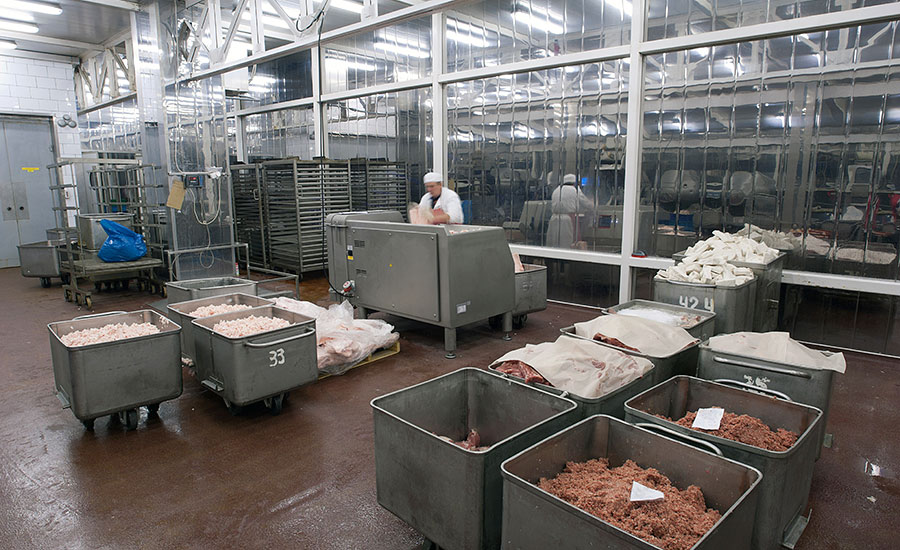So, you’re expanding operations and upgrading equipment. Maybe it’s time for a new packaging machine, or maybe a new grinder, splitting saw, etc.
You have a pretty good idea of what you want, you have been to the trade shows, spoken with product reps, watched demos and even spoken to people who own the machine you want to buy. You know what it will do, what it costs to maintain, what it costs to service, the expected return on investment (ROI), etc.
You buy it and get set up, but then you find there is a cost no one told you about — and it costs a fortune. What is that hidden cost? Cleaning it.
You get your first idea that something isn’t going as planned when your inspector acts like a bird dog and your new pride and joy is a pheasant. Every morning he or she finds something wrong with it: This isn’t clean, or the sanitizer is pooling there, or, worse, you’re in a RTE environment and it keeps showing up with positive LM samples.
I have seen this same scenario over and over. One example is the famous “Minneapolis Slicer.” It was purchased new. Six months later (and after a very expensive LM recall), it was sold to another establishment. About six months after that (and lots of positive product-LM) it showed up in a different establishment; however, it never made it to the production floor because they couldn’t get it to pass microbial testing, even after it was sent out for sterilization (the entire slicer was cooked at 160°F plus.
It was then sold again and disappeared only to show up in a retail store, where it was used for less than a month before the local health inspector threatened to shut the store down if they couldn’t get the smell under control. The last time I heard about it, the owner at that time was planning on selling it for scrap.
What was wrong with it? It was complicated.
The machine had a ton of parts, sealed areas, etc. The manufacturer stated that it was easy to clean, open this, take off that and spray it down. All you had to do was look at it and know that wasn’t true. The seals didn’t seal and the cracks and crevices were impossible to clean, let alone sanitize.
Did it do a great job of slicing? Yes, it did. It was fast, accurate and easy to operate. What it lacked was the ability to clean and sanitize.
Then there is the packaging machine that two people can operate all day, but it takes six people four hours a night to clean. That is three employees’ pay a day just to clean and sanitize.
So how do you avoid running into the same problem? Simple: Ask the right questions and do your research.
Find out what the tear-down actually entails — how many hours, how many people? Find out what sanitizers can be used on it and whether anything special is required?
When you talk to people who are already using it, ask them what it costs to clean and sanitize it, as well as if their inspectors pay special attention to it. Ask them if there have ever been any positive samples related to it?
Then look at it yourself. Does it have a lot of pieces? Are there a lot of moving parts that slide over each other creating hiding spots for product (and bacteria)? Also think about where you are going to put it in your establishment. If it takes high pressure to clean it, will your sewage system handle the extra flow?
Then talk to the sales rep again and ask them if the cost of cleaning and sanitizing is figured into the maintenance costs? Do they have a supported cleaning and sanitizing schedule? When I say supported, I mean, can they provide you with scientific results where they inoculated it, did a standard cleaning and resampled? Remember, your inspector is going to ask for support if it is something that will receive less than daily cleaning. Can the manufacturer provide that support? Has it been verified by a third party? Do current customers follow the recommended maintenance schedule or did they have to modify it?
You don’t to find out the hard way that the expensive seals fall apart when they get hit with sanitizer or worse, like the Minneapolis Slicer, they degrade but look good. When the health inspector told the story about the retail owner opening up the sealed control panel and the pus running out, she would turn green just remembering the smell.
You also don’t want to find out it requires a daily cleaning when you thought it was a weekly. The time spent cleaning and sanitizing are costs that you need to take into consideration before you make the purchase.
Modern equipment is amazing. It is fast, efficient and can really give you a head start, or it can become a money pit that you regret digging. It is always your decision, and while no one likes homework — except maybe teachers and consultants — if you are making an equipment purchase, this consultant is recommending you do your homework.
Summary of recent Beef Grinding Seminar
We R Food Safety recently hosted a seminar on “What records are really required when you grind beef?” Both the offices of Investigation, Enforcement and Audit (OIEA) and Field Operations (OFO) from the USDA’s Food Safety Inspection Service, as well as the state of Wisconsin meat-inspection program, made presentations. During the open discussion, representatives from each of the regulatory authorities and the state of Minnesota meat-inspection program joined the discussion and helped answer questions. Everyone in attendance greatly appreciated the speakers taking the time out of their busy schedules to attend and interact at the seminar.
During the presentations, attendees and speakers reviewed which records are required and what information they had to have, as well as how a Trace Back investigation is conducted. One critical item all speakers discussed was, to protect your establishment, you need to be able to pinpoint who supplied you with the components you use when grinding beef products.
Good discussion followed in the open forum about the different ways that beef grinders can maintain records, from very small operators who simply attach the information to a grinding log (i.e. cut it off the supplier box), to a variety of different batch sheets, to using electronic record keeping. We went over example forms and a demo of a paperless system that beef grinders can use to have the necessary records.
The take-home message was, although the FSIS proposal about grinding records hasn’t been published as a final rule, the different regulatory bodies needed the information in the proposed rule to effectively trace back potentially contaminated product to the source supplier. If a grinding facility can’t trace back to the source supplier, it becomes the “end of the chain,” and will be requested to initiate any potential recall and potentially be subject to liability.
We also briefly touched on daily sanitizing of grinding and packaging equipment and the need to keep those sanitation records, as well as briefly discussing how to lot source material to limit liability.
Based on feedback from those in attendance, we plan to host additional seminars on interventions grinders can use and options that are available to limit and control any potential growth of pathogens.






Report Abusive Comment